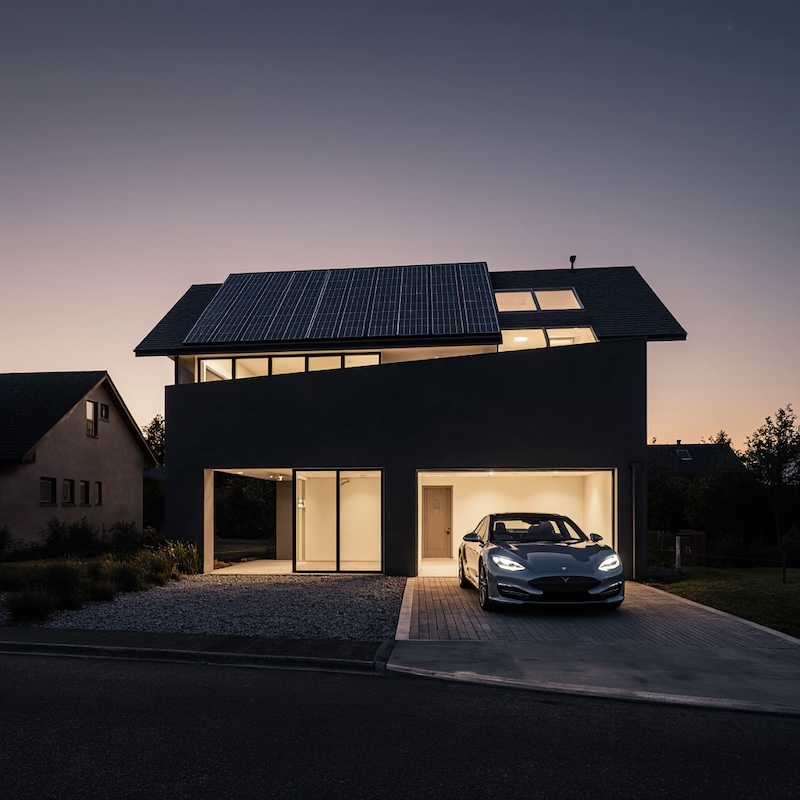
A smart two-stage energy management system optimizes electricity, heating, and EV charging in residential homes by strategically participating in day-ahead and intra-day energy markets to reduce costs and control battery aging.
Imagine your home not just consuming energy, but thinking about it—balancing heating, EV charging, solar energy, and battery life while reacting to real-time energy market prices. 🤯 That’s exactly what a team of researchers from Delft University of Technology explored in their latest study titled “Sequential Operation of Residential Energy Hubs.” Let’s break it down! 👇
A residential energy hub is a smart home setup that integrates multiple energy sources and storage systems:
☀️ Solar Photovoltaics (SPV)
🔋 Battery Energy Storage Systems (BESS)
🚗 Electric Vehicles with bidirectional charging (V2G)
🔥 Heat Pumps (HP) & Thermal Energy Storage (TESS)
🏘️ Smart Energy Management Systems (EMS)
These systems work together to provide electricity, heat, and mobility. But here's the twist: the energy markets themselves are complex and time-sensitive!
Electricity isn't just consumed—it’s bought and sold in real-time markets:
🏦 Your home's energy system can earn or lose money based on when it charges, discharges, or uses energy. But this requires smart planning.
The researchers developed a 2-layer smart controller:
This controller balances:
🌡️ Home comfort (temperature)
🔋 Battery health (avoiding unnecessary degradation)
🚙 EV readiness (fully charged when you need it)
💸 Energy cost savings
All while juggling complex price signals from multiple energy markets.
The researchers simulated a real home in the Netherlands with:
They tested different seasons, device setups, and market participation strategies using real data from 2021–2023. 📆🌦️
Here’s what stood out from their analysis:
Combining Day-Ahead and Intra-Day Auction planning gave the best cost savings.
💸 Lowest grid costs
🔋 Efficient battery use
🧊 Minimal impact on thermal comfort
Why? Because this policy predicts auction prices and takes advantage of cheaper intra-day energy opportunities.
So while heating matters, smart electricity storage is king 👑.
Allowing the EV to both charge and discharge gives:
🚘 More flexible grid interaction
💰 Greater savings
🔋 Better energy balance, especially in winter
In fast-charging-only mode, this advantage is lost.
This keeps your batteries lasting longer and performing smarter.
Price patterns and energy needs change with the seasons. The controller adapts accordingly for maximum efficiency. 🌞➡️❄️
🔍 The study showed through simulations that:
Even when the system “gamed” the market by over-promising in DA and correcting in IDA, it reduced cost without compromising comfort or violating system limits.
The research opens up some fascinating possibilities:
This research proves that energy management isn't just about tech—it’s about timing. By blending deep models of physics, user behavior, and market dynamics, residential homes can become powerful players in the energy system. 🏡⚙️📉
With smarter Energy Management Systems, we’re not just managing energy—we’re orchestrating it. 🎼🔋🌞
🧠 Energy Management System (EMS) - A smart software brain that controls how a home uses and stores energy—deciding when to charge your battery, run your heat pump, or buy from the grid. 🧠💡 - More about this concept in the article "Smart Green Energy: AI-Powered Campus Energy Management 🌱⚡".
📅 Day-Ahead Market (DA) - An electricity marketplace where energy is bought and sold one day in advance—like booking cheap tickets before a show. 🎟️⚡
⏱️ Intra-Day Market (IDA & CT) - Markets that let you adjust your energy plans closer to real-time:
🔋 Battery Energy Storage System (BESS) - A big rechargeable battery at home that stores energy (usually from solar panels) and uses it when electricity is expensive. 🪫➡️⚡ - More about this concept in the aticle "Charging Ahead ⚡ Smarter Storage Systems for Electric Trucks!".
🚗 Vehicle-to-Grid (V2G) - When your electric car doesn’t just charge—but also sends electricity back to the grid when needed. Your car becomes a mini power plant! ⚡🚙 - More about this concept in the article "How Electric Vehicles and Smart Grid Tech Are Transforming Energy Distribution ⚡🚗".
🔥 Heat Pump (HP) - An efficient device that uses electricity to heat or cool your home by transferring heat, kind of like a fridge working in reverse. ❄️➡️🔥 - More about this concept in the article "Heating the Future: How Poland is Transitioning to Renewable Heat Energy 🌬✨".
🌡️ Thermal Energy Storage System (TESS) - Stores heat (instead of electricity) to use later—like a thermos for your house, keeping it warm when energy prices are high. 🔥🧊
🧮 Model Predictive Control (MPC) - A smart forecasting system that plans the best way to use energy based on what's coming next—weather, prices, and user habits. 📈 - More about this concept in the article "Real-Time Flow Control with Lorentz Forces ⚡🧲".
🪫 Battery Degradation - The slow loss of battery capacity over time. Smart energy systems try to avoid wearing out batteries too fast. 🧓🔋
💸 Grid Cost (Cgrid) - The total money your home pays (or earns!) for energy from the power grid, depending on how smartly it trades electricity. 💵📊
Source: Darío Slaifstein, Gautham Ram Chandra Mouli, Laura Ramirez-Elizondo, Pavol Bauer. Sequential Operation of Residential Energy Hubs. https://doi.org/10.48550/arXiv.2507.20621